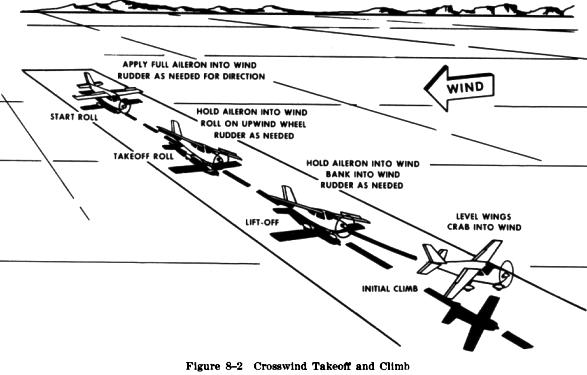| Crosswind Takeoff Roll
The technique used during the initial takeoff roll in a crosswind is generally the same as used in a normal takeoff, except that the aileron control must be held INTO the crosswind. This raises the aileron on the upwind wing to impose a downward force on the wing to counteract the lifting force of the crosswind, and prevents that wing from rising. As the airplane is taxied into takeoff position, it is essential that the windsock and other wind direction indicators be checked so that the presence of a crosswind may be recognized and anticipated. If a crosswind is indicated, FULL aileron should be held into the wind as the takeoff roll is started. This control position should be maintained while the airplane is accelerating until the ailerons start becoming sufficiently effective for maneuvering the airplane about its longitudinal axis. While keeping the wings level with the aileron control, the takeoff path must be held straight with the rudder (Fig. 8-2). Normally, this will require applying downwind rudder pressure, since on the ground the airplane (especially the tailwheel type) will tend to weathervane into the wind. When takeoff power is applied, torque or P-factor which yaws the airplane to the left, may be sufficient to counteract the weathervaning tendency caused by a crosswind from the right. On the other hand, it may also aggravate the tendency to swerve left when the wind is from the left. In any case, whatever rudder pressure is required to keep the airplane rolling straight down the runway should be applied. 
As the forward speed of the airplane increases and the crosswind becomes more and more of a relative headwind, the mechanical holding of full aileron into the wind should be reduced. It is when increasing pressure is being felt on the aileron control that the ailerons are becoming more effective. As the aileron's effectiveness increases and the crosswind component of the relative wind becomes less effective, it will be necessary to reduce the aileron pressure gradually to keep the wings level. The crosswind component effect does not completely vanish, so some aileron pressure will have to be maintained throughout the takeoff roll to keep the crosswind from raising the upwind wing. The use of proper aileron pressure then, is simply to keep this from happening. 
If the upwind wing rises, thus exposing more surface to the crosswind, a "skipping" action may result (Fig. 8-3). This is usually indicated by a series of very small bounces, caused by the airplane attempting to fly and then settling back onto the runway. During these bounces, the crosswind also tends to move the airplane sideways, and these bounces will develop into side skipping. This side skipping imposes severe side stresses on the landing gear and could result in structural failure. It is important then, during the crosswind takeoff roll, to hold sufficient aileron into the wind not only to keep the upwind wing from rising but to hold that wing down so that the airplane will, immediately after liftoff, be slipping into the wind enough to counteract drift.
|
